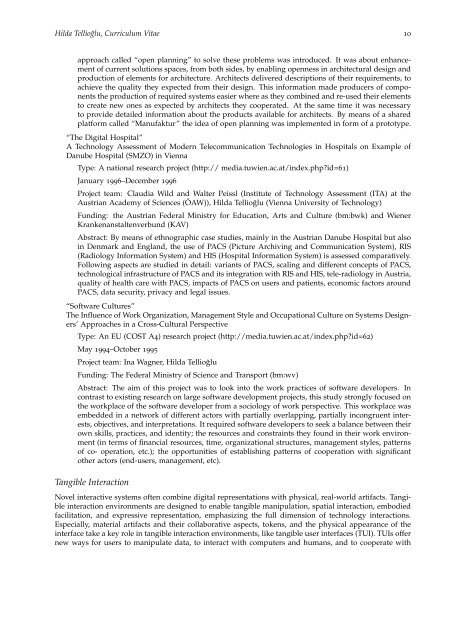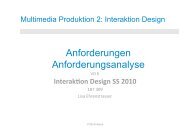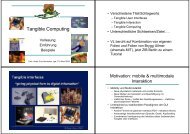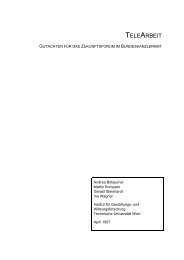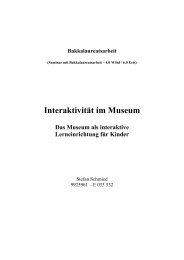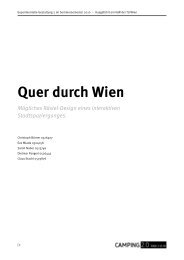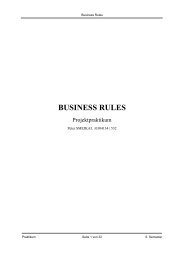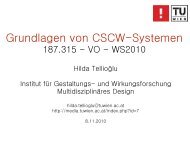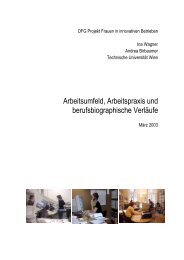Hilda Tellioglu, Curriculum Vitae - Technische Universität Wien
Hilda Tellioglu, Curriculum Vitae - Technische Universität Wien
Hilda Tellioglu, Curriculum Vitae - Technische Universität Wien
Create successful ePaper yourself
Turn your PDF publications into a flip-book with our unique Google optimized e-Paper software.
<strong>Hilda</strong> Tellio˘glu, <strong>Curriculum</strong> <strong>Vitae</strong> 10<br />
approach called “open planning” to solve these problems was introduced. It was about enhancement<br />
of current solutions spaces, from both sides, by enabling openness in architectural design and<br />
production of elements for architecture. Architects delivered descriptions of their requirements, to<br />
achieve the quality they expected from their design. This information made producers of components<br />
the production of required systems easier where as they combined and re-used their elements<br />
to create new ones as expected by architects they cooperated. At the same time it was necessary<br />
to provide detailed information about the products available for architects. By means of a shared<br />
platform called “Manufaktur” the idea of open planning was implemented in form of a prototype.<br />
“The Digital Hospital”<br />
A Technology Assessment of Modern Telecommunication Technologies in Hospitals on Example of<br />
Danube Hospital (SMZO) in Vienna<br />
Type: A national research project (http:// media.tuwien.ac.at/index.php?id=61)<br />
January 1996–December 1996<br />
Project team: Claudia Wild and Walter Peissl (Institute of Technology Assessment (ITA) at the<br />
Austrian Academy of Sciences (ÖAW)), <strong>Hilda</strong> Tellio˘glu (Vienna University of Technology)<br />
Funding: the Austrian Federal Ministry for Education, Arts and Culture (bm:bwk) and <strong>Wien</strong>er<br />
Krankenanstaltenverbund (KAV)<br />
Abstract: By means of ethnographic case studies, mainly in the Austrian Danube Hospital but also<br />
in Denmark and England, the use of PACS (Picture Archiving and Communication System), RIS<br />
(Radiology Information System) and HIS (Hospital Information System) is assessed comparatively.<br />
Following aspects are studied in detail: variants of PACS, scaling and different concepts of PACS,<br />
technological infrastructure of PACS and its integration with RIS and HIS, tele-radiology in Austria,<br />
quality of health care with PACS, impacts of PACS on users and patients, economic factors around<br />
PACS, data security, privacy and legal issues.<br />
“Software Cultures”<br />
The Influence of Work Organization, Management Style and Occupational Culture on Systems Designers’<br />
Approaches in a Cross-Cultural Perspective<br />
Type: An EU (COST A4) research project (http://media.tuwien.ac.at/index.php?id=62)<br />
May 1994–October 1995<br />
Project team: Ina Wagner, <strong>Hilda</strong> Tellio˘glu<br />
Funding: The Federal Ministry of Science and Transport (bm:wv)<br />
Abstract: The aim of this project was to look into the work practices of software developers. In<br />
contrast to existing research on large software development projects, this study strongly focused on<br />
the workplace of the software developer from a sociology of work perspective. This workplace was<br />
embedded in a network of different actors with partially overlapping, partially incongruent interests,<br />
objectives, and interpretations. It required software developers to seek a balance between their<br />
own skills, practices, and identity; the resources and constraints they found in their work environment<br />
(in terms of financial resources, time, organizational structures, management styles, patterns<br />
of co- operation, etc.); the opportunities of establishing patterns of cooperation with significant<br />
other actors (end-users, management, etc).<br />
Tangible Interaction<br />
Novel interactive systems often combine digital representations with physical, real-world artifacts. Tangible<br />
interaction environments are designed to enable tangible manipulation, spatial interaction, embodied<br />
facilitation, and expressive representation, emphasizing the full dimension of technology interactions.<br />
Especially, material artifacts and their collaborative aspects, tokens, and the physical appearance of the<br />
interface take a key role in tangible interaction environments, like tangible user interfaces (TUI). TUIs offer<br />
new ways for users to manipulate data, to interact with computers and humans, and to cooperate with


